Media | Articles
Maligned and misunderstood, East Germany’s tiny Trabant left an outsized legacy
For a heart-stopping moment in 1990, Martin Peters nearly became the headline of a grisly story in which the Eastern and Western German automotive worlds collided—quite literally—on the Autobahn. Peters, then head writer for MotorWeek, was in Germany filming a Porsche segment during the week of reunification. He was driving a 330-hp 928 GT, and, fittingly, decided to test the V-8 coupe’s claimed 165-mph top speed.
He saw 161 mph before fate—and the Porsche’s excellent brakes—intervened. Up ahead, a tiny car popped into the left lane from between two trucks traveling in the right one. Peters thought it was the end. He recalls the incident 22 years later, during another MotorWeek segment while with his current employer, Yamaha:
“I stood on the brakes as hard as I could. The ABS was working, doing everything it could, but there was no way I was going to miss hitting that car. And then finally, the driver of the car looked up and he saw me and trundled back over between the trucks. And the thing that surprised me was I didn’t know what kind of car it was. It was a Trabant!”

In that same segment, Peters introduces and drives his own Trabant, a 1964 version of the East German-built peoples’ car that he’s since restored to a standard well beyond factory spec. It’s now a rumbling, moving history lesson that draws a crowd at shows. It’s a safe bet that the Trabant’s creators at VEB Sachsenring Automobilwerke Zwickau never cast their petite vehicle in the role of 21st-century automotive ambassador—let alone as the figurehead of a Westward exodus. Here’s a brief look at the humble Trabant’s complicated history, and Peters’ efforts to keep his on the road.
From zero to hero
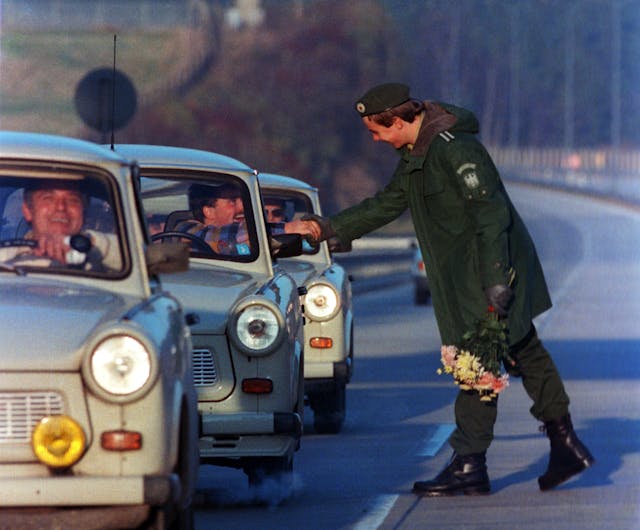
A frequent inclusion on “worst cars” lists, the Trabant was essentially unknown beyond Iron Curtain countries until the Berlin Wall came down in 1989 and it became an unlikely symbol of freedom. Nightly television newscasts showed a “trail of Trabis” crossing the border, ferrying occupants to a vastly different Germany than the one that had essentially held them captive for decades.
Marketplace
Buy and sell classics with confidence
Some of those Trabis continued to amble over German roads even after East and West were reunited in October of 1990. With a maximum speed around 60 mph, however, these cars proved dreadfully incompatible with Western driving conditions, and most owners abandoned them. The Trabants were once again unloved and worthless … until they weren’t.
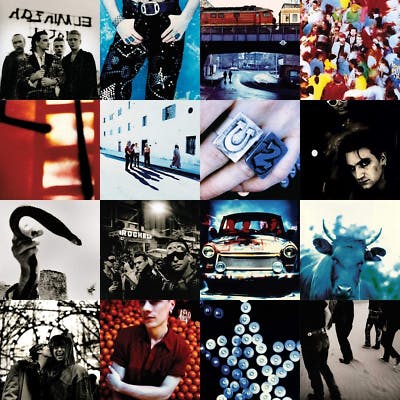
In 1992, superstar rock band U2 elevated the Trabant to Western fame. After seeing and driving the cars during Berlin recording sessions for their seminal album Achtung, Baby, the group included a photo of one in the cover art. Gutted and provocatively painted Trabants were used as spotlight fixtures for the group’s 1992 “Zoo TV” stadium concert tour. West, meet East. In Europe, cast-off Trabants found new homes among artists, customizers and sightseeing tour companies, and Trabants began emigrating to the U.S. as oddly compelling playthings for car nerds.
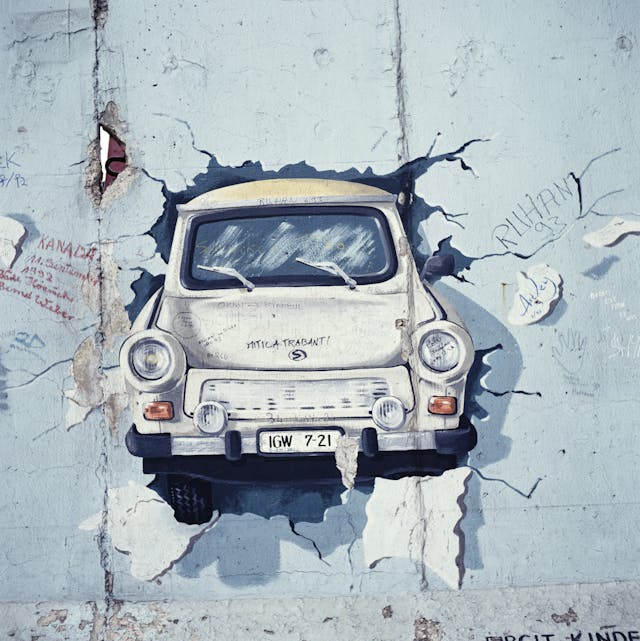
Before carbon fiber, cotton fiber
West Germany had the Volkswagen Beetle; East Germany had the Trabant. The latter was built by state-owned VEB Sachsenring Automobilewerke Zwickau in a former Auto Union factory that had once built Horch luxury models. Although to most it symbolizes the failure of communist East Germany’s centrally planned economy, the Trabant had some redeeming technical qualities when introduced in 1957—at least, on paper.
The tiny Trabant stretched just 142 inches long on an 80-inch wheelbase and weighed 1400 pounds. It boasted front-wheel drive and four-wheel independent suspension courtesy of transverse leaf springs. The car’s most intriguing feature was a body made from a composite called Duroplast, a mixture of cotton-fiber waste from textile factories combined with phenol resin and draped over the car’s steel bones.
“The Trabant is much maligned for its engineering and execution, but wrongly so, I think,” Peters says. “It was designed with composite body panels fastened to a steel skeleton. General Motors did something similar years later with the Pontiac Fiero.”
He also points out that the transverse leaf springs “not only suspend the car, but serve as control arms and save weight and material.”
Faced with limited resources allocated by the regime, the Trabant’s engineers were forced to get creative. The 18-hp, 499-cc two-cylinder, two-stroke air-cooled engine, for example, was based on an older DKW design. A 23-hp, 594-cc version arrived for 1960. In 1964, the Trabant 601 model brought a redesigned body that somewhat resembled a cartoonishly shrunken and distorted Peugeot 404.
Inefficient production kept customers on a 10-year-plus waiting list for a Trabant. Unsurprisingly, used Trabants could sell for more than new ones. (Whiff of capitalism, anyone?) The Trabant 601 remained largely unchanged until 1990, when a VW 1.0-liter four-stroke, four-cylinder engine replaced the old two-stroke. This was the result of a trade agreement made between East and West Germany before reunification had crossed anyone’s mind. Trabant production ended in 1991 after a run of over 3 million cars, and VW eventually bought the factory.
Packing material
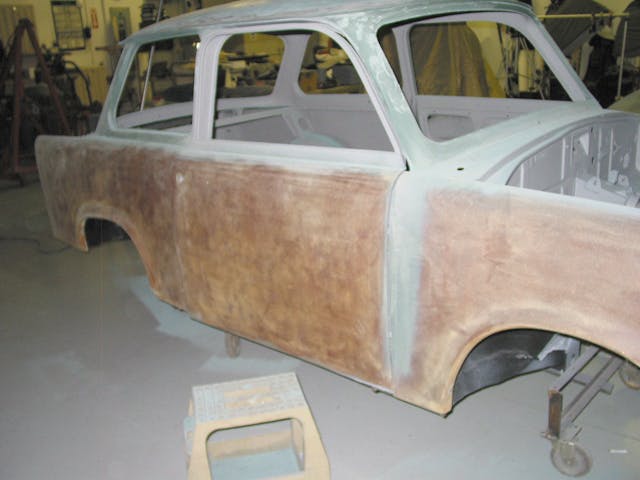
Years after Peters’ near-miss on the Autobahn, he spotted a Trabant in the garage of a friend who had shipped some cars overseas from Germany. In the same shipping container as a wrecked Porsche 935 race car sat two Trabants—“packing material,” he says. Peters bought the ’64 601 Deluxe model, which featured two-tone paint and chrome exterior trim.
He commissioned Birchwood Automotive in Creston, Ohio, to restore the Trabant. The shop, owned by Mike Mavrigian, had worked with Peters during his stint with Michelin’s public relations team and, later, with Porsche Cars North America. Working with Mavrigian on the Trabant were shop members Rob Holland and Larry Ritz.
The Trabant’s most innovative feature—its Duroplast body—presented the project’s biggest challenge. Though it had suffered no crash damage, the generally low-quality factory finish showed rippling and delamination. Mavrigian recalls that sanding the top layer of resin revealed a surface that looked like “a cardboard box.” (Misinformation about the Trabant’s composite body being made with cardboard had been circulating for years.)

“We had to re-resin the whole thing. We sanded it down, applied two coats of resin, then block-sanded that,” he explains.
The doors did not close properly, an issue that forced them to reposition the hinges. The exterior chrome was original and intact but needed replating. Mavrigian sent it to a shop that typically handles high-end restorations, asking for a basic job that he expected to cost about $50.
“The parts came back looking like jewels,” he says. The bill returned with a figure in the hundreds place: $250. Still, Peters was pleased when he saw the result. “They never made them this nice.”
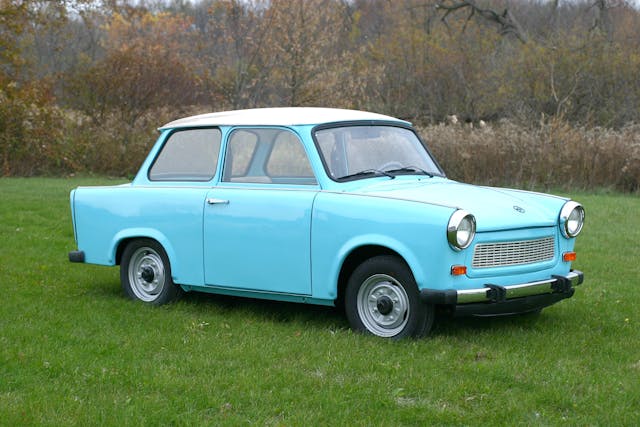
Language barrier
Sourcing parts from the former East Germany was a challenge of language rather than supply. Between Mavrigian’s rudimentary German and suppliers’ token English, a few incorrect parts arrived on the doorstep of the Ohio shop. Some, such as wheel bearings, could be substituted, but others had to be fabricated.
Mavrigian and his crew rewired the car, building a new wiring harness to match the original. They also rebuilt the fuel tank, which sits above the engine for a gravity-feed fuel system. Peters planned to rebuild the engine himself.
Oooh, oooh, that smell!
Mavrigian’s team redid the interior, from carpeting to headliner, first stripping it down to the Duroplast. Finding the correct upholstery material took legwork, but the first major hurdle to clear was … the smell. The Trabant’s original seat cushions were stuffed with horsehair that absorbed moisture and, years later, produced an unspeakably foul odor. “I opened the door and nearly passed out,” Mavrigian says.
Finishing the cabin is a Momo steering wheel with a custom-made Trabant logo center cap. Mavrigian also fashioned an aluminum shift knob and exterior door handles on his lathe.
The Trabant experience

Peters occasionally drives his Trabant, and once hit 100 km/h drafting a Porsche 911 during the 2012 MotorWeek segment. “Considering I set the alignment with a tape measure, it felt pretty good,” he remembers. “I will only drive the Trabi on two-lane highways. It’s light enough for me to transport on a single-axle trailer.”
Owning and driving a Trabant takes practice—starting with refueling. There’s no gauge, so a stick is needed to measure the six-gallon tank. You must add the correct amount of two-stroke oil (about three percent) and avoid spilling gas on a hot engine.
Other mechanical oddities: The gearshift pattern is reverse of what most would expect from a column shifter, and freewheeling only works in fourth gear. From the other gears, you must shift into neutral to coast. Peters taught his daughter to drive a stick shift and now has her working on mastering the Trabant’s.
Keep on Trabanting

Peters keeps the Trabant in his shop in North Georgia, where he is restoring a Lotus Esprit V8 and an Alfa Romeo Spider. He makes any needed repairs to the Trabant himself, and, as original owners in Eastern Europe discovered, that sometimes requires improvisation.
The car once left Peters stranded on the roadside for a few hours with no fuel reaching the carburetor, until he realized that a very small hole in the gas cap was actually a clogged vent. “I carry a pin with me now,” he says. “In its effort to regulate vapor from portable fuel cans, the EPA even forgot about the necessity of venting, so I don’t feel too bad about my slow diagnosis.”
Recently, the starter solenoid failed due to a cracked plastic housing. When Peters could not find a suitable replacement, he rebuilt it using epoxy, fiberglass mat, and “careful grinding and shaping.”
Trabants and their parts are available from Europe, but Peters says fewer online vendors and eBay sellers are willing to ship to the U.S., and that shipping costs are very high. “I recently purchased an NOS fuel valve and paid as much for the shipping as for the part.”
Facebook and spies
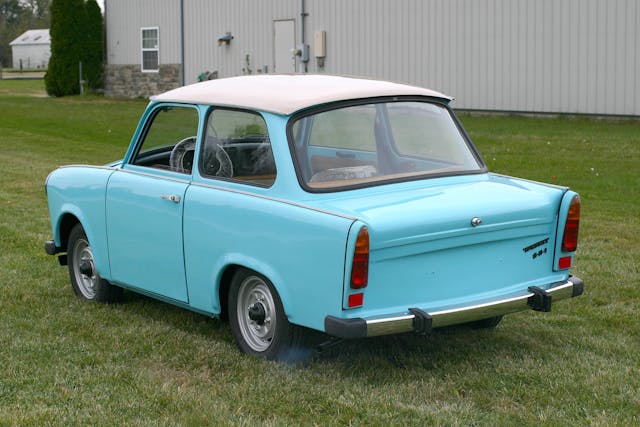
Peters cites the global Trabi community as a good source of support. He connects with other owners on Facebook, and his car is listed in the Trabant Registry. “In spite of greater recognition these days, it is always the most unusual car at any show,” he says.
Connecting with its Cold War roots, the East German minicar has its own annual Parade of Trabants conducted by The International Spy Museum in Washington, D.C. The event went global and virtual in 2020, and will repeat the recipe on November 13, 2021.
Peters sees the Trabant as much more than a curiosity or oddball toy, citing it as an important historical marker.
“Not unlike firearms designed by Kalashnikov and aircraft designed by Mikoyan-Gurevich, the Trabant 601 is a great example of what engineers can achieve with scarce resources,” he says. “At the same time, the Trabant is a cautionary tale on wheels. The scarcities the engineers faced were unnecessary, the result of tyranny and attempts at central planning. I make sure my children and their curious friends understand what this car represents and why that matters even more today.”
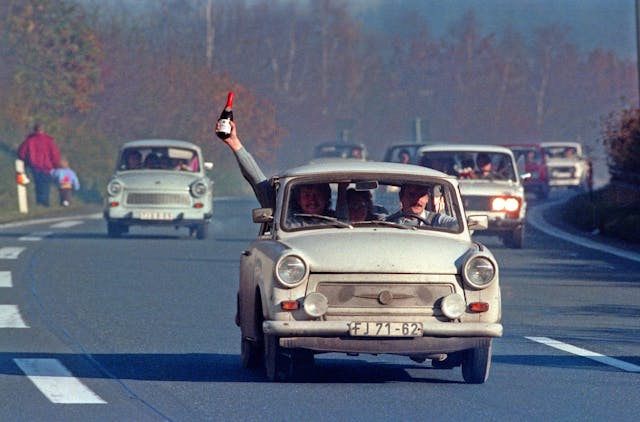


















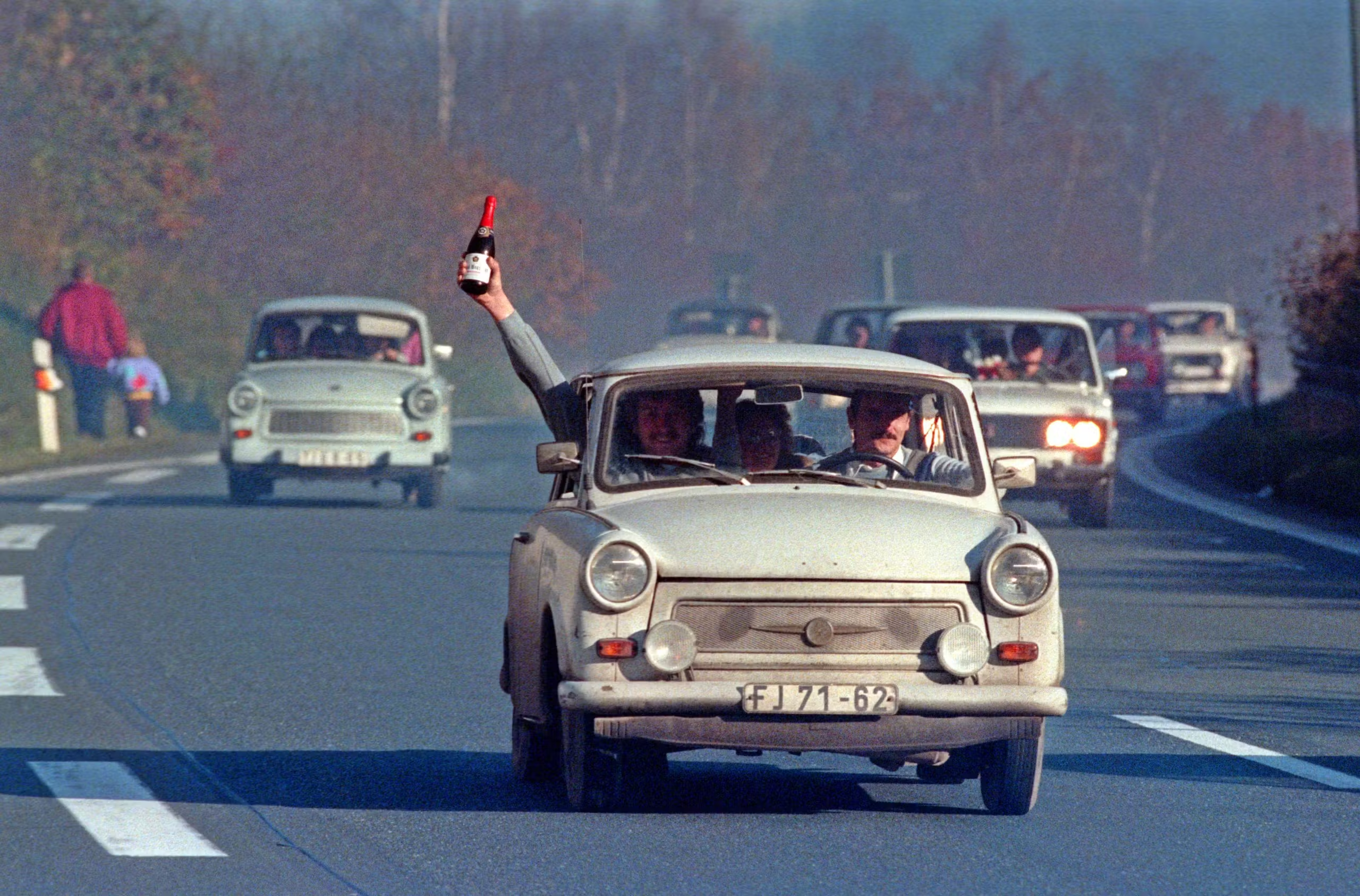
My deceased daughter in law’s father who lived in Poland said he was holding out for an opportunity to buy a Fiat rather than settling for a Trabant.